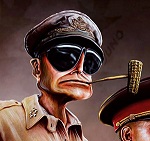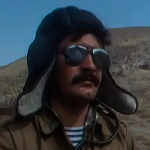|
HEY GAL posted:well, the Army of Flanders, which is superbly trained and blessed with sky-high morale, can make the blistering speed of...4.5 miles a day. I can't read Wallenstein's handwriting, and even for a nominal Polish/German Is the letter actually more frantic than most of the ones you read, or is it more along the lines of "Dear friend, we are about to have most unwholesome sexual acts performed upon us by the perfidious Swedes, so if it would not be too much trouble could you expedite your relocation over here?"
|
|
|
|

|
| # ? May 27, 2024 18:42 |
|
Kaal posted:Well none of the internment camps held American citizens, you're referring to the assembly and relocation centers. Which, actually, ended up being ruled constitutional when the Supreme Court ruled on the issue. Sometimes the Supreme Court is full of old racist butts.
|
|
|
|
wdarkk posted:Sometimes the Supreme Court is full of old racist butts. But they still get to define what is constitutional and what isn't, regardless.
|
|
|
|
wdarkk posted:Sometimes the Supreme Court is full of old racist butts. Deteriorata posted:But they still get to define what is constitutional and what isn't, regardless. Right. Which is also why young legal-eagles soon learn that "constitutional" shouldn't be treated as synonymous with "moral and just". Kaal fucked around with this message at 02:39 on Jul 17, 2015 |
|
|
|
Rabhadh posted:Agreed. Crossing out all references to bearded axes in the history books, good call goon. wow, good job shutting me down there. bravo.
|
|
|
|
Kanine posted:wow, good job shutting me down there. bravo.
|
|
|
|
TheFluff posted:Re: synthetic fuel, anyone know why the Germans never went for ethanol? In Sweden most military vehicles (including tanks) plus most agricultural machinery that wasn't practical to run on wood gas were run on ethanol/gasoline mixes in either 50-50, 75-25 or 85-15 proportions (everything that is old is new again, today you can buy 85-15 ethanol/gasoline as "E85" at most gas stations). When speccing out engines for tank production the contract included a clause that said the engines were to be factory-tuned for 50-50 gasoline/ethanol but should be easily adjustable to run on either 85-15 or pure ethanol if the need arose. 100% pure gasoline was almost exclusively reserved for the air force. Do you know how Sweden was producing the ethanol? My guess is that it was far easier and cheaper for Germany to use their abundance of coal to make synthetic fuels than to grow the crops for ethanol production.
|
|
|
|
Monocled Falcon posted:Can I get an effort post on Napoleonic artillery? I'm mostly trying to get a sense of how many pounds of lead are flying through the air compared to other time periods, like the early modern. This is mostly from Engineering the Revolution: Arms and Enlightenment in France by Ken Alder, which is a fascinating history of technology. By the 18th century, artillery had come into its own as a battlefield arm. Constant sieges during the War of Spanish Succession, and the tactical use of light cannons on the battlefield by Gustav Adolphus and Maurice of Nassau, demonstrated that mastery of artillery was necessary for a modern state. The logistical advantages of standardizing on a small number of pieces and calibers, which could be produced en mass, were immediately obvious, but standardization by whom and to what ends were matters of extensive debate. Through the early modern period, French cannon were cast in a variety of lengths sizes to fit the different need of field, siege, and naval cannons. Each regional foundry cast shot of slightly different size, which were fired from tubes mounted on carriages whose dimensions varied based on locality. These specialized guns were optimized for a specific role, but could not be interchanged. Command of the guns was divided between the Corps Royal, responsible for the manufacture, maintenance, organization and supply of guns and their aiming and firing in sieges, and the Royal Artillerie, responsible for protecting the guns and commanding them in the field. The situation was, to put a bluntly, a royal mess. In 1715, immediately after the death of Louis XIV, Jean-Florent de Valliere was appointed director general of the artillery. In 1732, he instituted his famous Valliere system, specifying 5 classes of cannons in 4, 8, 12, 16, and 24 lbs, and prohibiting any deviation from the official weights and dimensions. I’ll quote Alder at length here. “The Vallière system combined a simplified administrative structure with a conscious appraisal of the wars of the period. The same artillery pieces were now to be used for coastal and fortress defenses and for sieges and campaigns in the field. To enable them to fit into prepared emplacements, all the cannons had been given the same length. And because they had to batter down the walls of fortresses from perimeter trenches, they had to be capable of propelling the heaviest caliber shot a considerable distance, and hence possess sufficient thickness to withstand a tremendous charge.” Valliere also dumped the Corps Royal and Royal Artillerie for semi-permanent artillerists subject to military discipline and trained at military colleges, and all trained in uniform course of mathematics, engineering drawing, metallurgy, and practical gun-laying and ballistics. These guns were the perfect weapons for the wars France had been fighting since 1680, characterized by sieges of massive forts close to the French borders. They were notably inferior to the artillery of rival powers in the Seven Years War in both number and quality. The French 4-pounder weighed twice as much the Prussian equivalent. French armies abandoned many of their cannons in defeat, and Marshal Broglie started improvising lighter field guns not in the Valliere system and distributing them to infantry formations, against the explicit advice of the artillery service. Valliere himself passed away 1759, at the age of 93, 3 years into the war. The great reformer was Jean-Baptist Vaquette de Gribeauval, born to one of the recently ennobled families in 1715. Gribeauval witnessed Prussian tests of their lightweight cannon in 1755, and then served as a general with the Austrian army, where he distinguished himself in the defense of Schweidnitz. After the war, Gribeauval was appointed director-general with a mission to reform the artillery. Gribeauval introduced a new pattern of lighter field guns, and new methods of manufacturing using horizontal boring techniques. He also argued for a doubling of the numbers of guns in the army, and reorganizing the artillery regiments to remove the last vestiges of an infantry-style organization. From now on, the gun would be the center of everything. He introduced a number of minor changes in carriage design, and training that standardized the drill of gun crews (previously, guns had been served by a few expert loaders and aimers, and moved by any soldiers the artillerists could gather up that day). Gribeauval’s guns were shorter ranged and less powerful than the old Valliere cannon, but could be moved and massed on the battlefield, giving commanders a tactical edge. As Alder describes it, the Gribeauval system won not so much because it was technically superior to the Valliere system, but because it more successfully engaged with professional rationalization and the role of artillery on the battlefield against the old system. Gribeauval’s guns were the ones that Napoleon fought with. He introduced further changes in the Year IX system, which eliminated the 4 and 8 lbrs in favor of a 6 lb cannon, and there were minor improvements to the limbers, but the guns themselves were much the same. The Napoleonic ideal of cannon was as a decisive and mobile arm carried forward into contact with the enemy along with the infantry. An average general might parcel their guns out along the line in battery of 4 to 6 to add a little range and punch to the infantry, but a truly great commander like Napoleon would group the guns into a Grand Battery of 50 to 100 guns, and use it to blast a hole in the enemy’s army at the decisive point of battle. My research on the tactical side is a little weaker (or rather, I don’t have anything as interesting on Engineering the Revolution on hand for it), but from some googling your typical 12 lbr cannon would have a range of about 900 yards, and be capable of between 1 to 4 shots per minute depending on the skill of the crew. Anybody hit with a cannon ball is going to be hosed up. Men are a lot less durable than ships or earthworks, and even a glancing hit could take off an arm or leg. Cannonballs could be aimed to bounce off the ground to extend their range, and a great gunner would be able to hit a column of men at chest height, killing several people in a single shot. Cannon were particularly effective against infantry squares, where you could hit both sides of the formation, or enfilade the edges. The problem was that even ‘light’ guns were massive. The Canon de 12 Gribeauval weighed 880 kg and had a crew of 15 men and 6 horses to service it. A 900 yard range is impressive compared to the 100 yard range of musketry, but still not particular long compared to a battlefield. Get the ‘decisive point’ point wrong for your Grand Battery, and you won’t have any fire support at all. You asked about weight of fire, and I'd say it's a fairly substantial increase. Compared to the Early Modern, there are a lot more cannons, they're more likely to be in range of something worth shooting, and professionalization and drill means that they can get off a lot more shots in the same period. The next big advances are rifled barrels of built up construction (Armstrong and Parrott guns), which get around the mechanical limits of bored-cast iron, explosive shells replacing solid shot, and finally recoil mechanisms enabling true rapid fire with the French Canon de 75 model 1897.
|
|
|
|
That was an interesting read, thank you! Sucks to be Napoleonic infantry. Then again... how did Napoleonic assault columns work? And how did you get guys to go in the front of it, when the first layers are definitely not going to survive?
|
|
|
|
GreyjoyBastard posted:I can't read Wallenstein's handwriting, and even for a nominal Polish/German quote:der feindt marchirt hereinwarts der herr... quote:the enemy's marching in this direction my lord... Referring to a good friend of his in the third person is pretty polite, but it's a lot sparser than the kinds of letters that take half the first page to dispose of the sender's and recipient's titles, and he's not referring to himself as "we," which could indicate the closeness of his relationship with Pappenheim but could also indicate that he simply forgot. If it was a mistake, he has no time to correct it. (I've read a bunch of letters from Mansfeld where he referred to himself as "I" and then crossed out every "I" and replaced it with "We." But he was very stressed about his funding at the time.) Probably at the time the letter would have looked almost as fast and peremptory as some sort of Morse Code message. And even at the calmest times, these people have a loose relationship with punctuation at best. His spelling owns btw, and probably reflects the way his speech sounded pretty well. Steinrokkan, can you pronounce ü? Because I don't think Wallenstein can. HEY GUNS fucked around with this message at 14:48 on Jul 17, 2015 |
|
|
|
What was the primary cause of the war of 1812? In school (in America) I was taught that it was a combination of British raiding and impressing United States shipping and the British arming hostile native tribes to curb US expansion but apparently in Canada they are taught that the United states sought to conquer Canada which I literally never heard of before.
|
|
|
|
100 Years Ago Good News: The lack of anything of grand strategic importance means I can go where I like best, stories of everyday life from people on the ground. Kenneth Best is waiting to be evacuated (and still complaining about shirkers), while Louis Barthas is busy in the rear areas building a better hole. Bad News: The roulette wheel landed on "Armenian Genocide". We're with the deportation caravans as they head by the most indirect route possible for the Syrian desert.
|
|
|
|
TheFluff posted:When speccing out engines for tank production the contract included a clause that said the engines were to be factory-tuned for 50-50 gasoline/ethanol but should be easily adjustable to run on either 85-15 or pure ethanol if the need arose. They were going to give soldiers ready access to thousands of litres of industrial-strength ethanol? How was that supposed to end well?
|
|
|
|
Man Whore posted:What was the primary cause of the war of 1812? In school (in America) I was taught that it was a combination of British raiding and impressing United States shipping and the British arming hostile native tribes to curb US expansion but apparently in Canada they are taught that the United states sought to conquer Canada which I literally never heard of before. The war actually started with an (incompetent) invasion of Canada by the US. (Does the US literally teach that the war was entirely the fault of the evil British? feedmegin fucked around with this message at 12:47 on Jul 17, 2015 |
|
|
|
xthetenth posted:It pretty much seems like the Japanese decided that to win the war they needed to win the battle, came up with a maybe for the battle and went from there without making sure they would win the war that way. They somehow missed they were going up against the world's largest power, not the b-team of Imperial Russia, the dysfunctional backwater of Europe. The US in 1940 was not in any obvious way to contemporaries 'the worlds largest power' - its navy was decent but smaller than the RN amd its army tiny. High population but that was true of imperial Russia too, and high levels of industry arent as important if the war is short and ends in a decisive battle before it can be brought into play.
|
|
|
|
JcDent posted:That was an interesting read, thank you! If you look at my post history, I made a post on an infantry battalion attack a little while ago. You get guys to go in the front the same way that you get guys in the modern military to do anything dangerous - training, discipline, and a sense of duty. The guys in front also survive quite a bit, since they were only "in front" for what is essentially the movement to contact. You're vastly overestimating the effectiveness of Napoleonic firearms. The truly dangerous poo poo was first guy in to a defended breach. Usually, breaches were stormed by a volunteer party, and the first man up who survived would be promoted or otherwise rewarded.
|
|
|
|
Was it this tread that had a bit about the difference in the size of touch holes between the 7 years war and the Napoleonic wars? Namely that the 7 years war touch holes were much bigger to allow for faster firing, but as a result were much less accurate?
|
|
|
|
Rabhadh posted:Was it this tread that had a bit about the difference in the size of touch holes between the 7 years war and the Napoleonic wars? Namely that the 7 years war touch holes were much bigger to allow for faster firing, but as a result were much less accurate? why would the size of the vent make any difference
|
|
|
|
Most Napoleonic artillery used reed fuses, which would much faster to use than the touch hole filled with powder. Anyway, the impact of venting more force out of the touch hole would be to slightly decrease your cannon ball's velocity, not accuracy.
|
|
|
|
Man Whore posted:What was the primary cause of the war of 1812? In school (in America) I was taught that it was a combination of British raiding and impressing United States shipping and the British arming hostile native tribes to curb US expansion but apparently in Canada they are taught that the United states sought to conquer Canada which I literally never heard of before. The Americans would have very gladly gobbled up British North America in that war just like they tried to do in the War of Independence. The fact Britain was in the third decade of war against the man who controlled most of Europe just gave them the best chance to do it. Impressment was rather galling, too.
|
|
|
|
KYOON GRIFFEY JR posted:Most Napoleonic artillery used reed fuses, which would much faster to use than the touch hole filled with powder. What's a reed fuse? Google tells me nothing.
|
|
|
|
HEY GAL posted:why would the size of the vent make any difference Faster due to not needing to pour powder into the pan, less accurate as more gas is vented out the touch hole. KYOON GRIFFEY JR posted:Most Napoleonic artillery used reed fuses, which would much faster to use than the touch hole filled with powder. I'm actually talking about muskets and not cannons here
|
|
|
|
Man Whore posted:What was the primary cause of the war of 1812? In school (in America) I was taught that it was a combination of British raiding and impressing United States shipping and the British arming hostile native tribes to curb US expansion but apparently in Canada they are taught that the United states sought to conquer Canada which I literally never heard of before. To utterly gently caress over the Great Lakes natives.
|
|
|
|
The Lone Badger posted:What's a reed fuse? Google tells me nothing. A section of a reed, filled with powder, that sticks in the touch hole of an artillery piece and pierces the charge below it. You light the end of the reed. Much better than having to pour powder in the touch hole.
|
|
|
|
Rabhadh posted:Faster due to not needing to pour powder into the pan, less accurate as more gas is vented out the touch hole.
|
|
|
|
Rabhadh posted:Faster due to not needing to pour powder into the pan, less accurate as more gas is vented out the touch hole. The British used the Land Pattern Musket for both conflicts, and the French used the Charleville for both as well. It looks like from a brief wikipedia-ing that the primary changes based on the Seven Years' War were shortening of the barrel for the Land Pattern and a heavier construction and revised butt stock for the Charleville. I really do not think that the size of the touch hole has a significant impact on the rate of fire. There is a lag as the flint strikes, but it's a very small component of the overall time of the process to shoot. You always need to prime the weapon.
|
|
|
|
Can someone tell me a bit about later cannon circa 1850 and what changes in regards to the firing mechanisms? The Taiping are complaining that the western guns are accurate and powerful, but not that useful because the small parts break and they don't have anyone on hand who can fix them.
|
|
|
|
P-Mack posted:Can someone tell me a bit about later cannon circa 1850 and what changes in regards to the firing mechanisms? The Taiping are complaining that the western guns are accurate and powerful, but not that useful because the small parts break and they don't have anyone on hand who can fix them. are they referring to the sight, which is a delicate pendulum of brass? are you sure they're not referring to muskets? HEY GUNS fucked around with this message at 14:44 on Jul 17, 2015 |
|
|
|
KYOON GRIFFEY JR posted:The British used the Land Pattern Musket for both conflicts, and the French used the Charleville for both as well. It looks like from a brief wikipedia-ing that the primary changes based on the Seven Years' War were shortening of the barrel for the Land Pattern and a heavier construction and revised butt stock for the Charleville. Maybe I'm misremembering something so, I'm not sure where I read the bit about touch hole sizes
|
|
|
|
HEY GAL posted:there are no small parts in a muzzle firing black powder cannon, it's a tube of iron or brass with a small hole at one end and a big hole at the other. The only thing that I can think of is that the cannons used a flintlock, which was quite common for naval guns, but that is easily replaceable by a touch hole design. They could also be referring to parts of the carriage, but I would think the enterprising Taiping could fix up a new one pretty quickly.
|
|
|
|
KYOON GRIFFEY JR posted:The only thing that I can think of is that the cannons used a flintlock, which was quite common for naval guns, but that is easily replaceable by a touch hole design. This was in a naval context, so maybe that's it. Or as Hey Gal suggested, might have been a non sequitur comment about small arms. Western carriages were apparently much more complex than Chinese ones; Li Xiucheng says that there's no point in trying to replicate western guns unless you can reproduce their carriages as well.
|
|
|
|
Taerkar posted:To utterly gently caress over the Great Lakes natives. To expound on this, the US had been trying to push those natives off their land ever since the Peace of Paris. Tecumseh and his brother spent a lot of time trying to unify the natives into a single force, with limited success. The British were supporting him, and had established a number of forts in nominally American territory to do so. And to protect/control the fur trade. So there was a lot of desire to push the British out. If it had just been a bunch of poor sailors getting a first hand look at the fine traditions of the British Navy, I doubt there would have been a war.
|
|
|
|
Raskolnikov38 posted:Do you know how Sweden was producing the ethanol? My guess is that it was far easier and cheaper for Germany to use their abundance of coal to make synthetic fuels than to grow the crops for ethanol production. Byproduct from pulp wood processing. The Swedish forestry and wood pulp sector was very big at the time (and to some extent it still is) and the sulfite process was quite widely used. I guess the Germans didn't have all that much of that at the time? The Lone Badger posted:They were going to give soldiers ready access to thousands of litres of industrial-strength ethanol? How was that supposed to end well? TheFluff fucked around with this message at 16:16 on Jul 17, 2015 |
|
|
|
Taerkar posted:To utterly gently caress over the Great Lakes natives. If I recall correctly, one of the bigger drivers behind American independence in the first place was because the Americans wanted to expand westwards after the British had already promised the natives there that they wouldn't and tried to stick by the agreements.
|
|
|
|
Tomn posted:If I recall correctly, one of the bigger drivers behind American independence in the first place was because the Americans wanted to expand westwards after the British had already promised the natives there that they wouldn't and tried to stick by the agreements. Britain not stabbing the natives on the first chance they had? What the hell?
|
|
|
|
JcDent posted:Britain not stabbing the natives on the first chance they had? What the hell? Guess who had to pay to defend the colonies from the resulting native reprisals? (Clue: not the colonies)
|
|
|
|
JcDent posted:Britain not stabbing the natives on the first chance they had? What the hell? Hey, colonial soldiers on active duty are expensive, y'know. Can't fight a permanent war on the frontiers all sodding day. But perhaps if we could set off their expense with, say, some kind of tax...? Edit: OH poo poo WAIT BAD IDEA BAD IDEA AAAAA Tomn fucked around with this message at 16:36 on Jul 17, 2015 |
|
|
|
JcDent posted:Britain not stabbing the natives on the first chance they had? What the hell? In the British Era the natives were treated well, in that the crown made treaties and actually kept them. With the Americans treating native populations so badly, it was a smart political move.
|
|
|
|
HEY GAL posted:there are no small parts in a muzzle firing black powder cannon, it's a tube of iron or brass with a small hole at one end and a big hole at the other. Circa 1850 is when you start seeing functional/practical breech-loaders, which the British used during the Second Opium War. These were multipart barrels, it was a tube of iron which was then strengthened by taking hoops of iron with an inner diameter slightly smaller than the barrel itself, heating them up until they expanded enough to slip down over it, and then letting them cool. The breech block system itself had a number of parts, with an obturating block/plug combination held into place by a hollow screw that was tightened for force the plug into the breech and hold it there. And depending on the size of the gun and its mounting, there could have been other parts for elevation/traverse.
|
|
|
|

|
| # ? May 27, 2024 18:42 |
|
JcDent posted:Britain not stabbing the natives on the first chance they had? What the hell? Also, the fur trade. Quite lucrative. Not as much as much as, say, sugar, but certainly worth something. The natives do the hunting, and you set up trading posts to swap booze and consumer goods for them. Then you gotta protect the posts, and, well, if the rebels can't even force project into Pennsylvania, how are they going to stop you from building forts in Michigan?
|
|
|


































